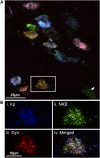KNDy Cells Revisited
- PMID: 30010844
- PMCID: PMC6098225
- DOI: 10.1210/en.2018-00389
KNDy Cells Revisited
Abstract
In the past decade since kisspeptin/neurokinin B/dynorphin (KNDy) cells were first identified in the mammalian hypothalamus, a plethora of new research has emerged adding insights into the role of this neuronal population in reproductive neuroendocrine function, including the basis for GnRH pulse generation and the mechanisms underlying the steroid feedback control of GnRH secretion. In this mini-review, we provide an update of evidence regarding the roles of KNDy peptides and their postsynaptic receptors in producing episodic GnRH release and assess the relative contribution of KNDy neurons to the "GnRH pulse generator." In addition, we examine recent work investigating the role of KNDy neurons as mediators of steroid hormone negative feedback and review evidence for their involvement in the preovulatory GnRH/LH surge, taking into account species differences that exist among rodents, ruminants, and primates. Finally, we summarize emerging roles of KNDy neurons in other aspects of reproductive function and in nonreproductive functions and discuss critical unresolved questions in our understanding of KNDy neurobiology.
Figures


References
-
- Knobil E. The neuroendocrine control of the menstrual cycle. Recent Prog Horm Res. 1980;36:53–88. - PubMed
-
- Belchetz PE, Plant TM, Nakai Y, Keogh EJ, Knobil E. Hypophysial responses to continuous and intermittent delivery of hypopthalamic gonadotropin-releasing hormone. Science. 1978;202(4368):631–633. - PubMed
-
- Savoy-Moore RT, Swartz KH. Several GnRH stimulation frequencies differentially release FSH and LH from isolated, perfused rat anterior pituitary cells. In: Mahesh VB, Dhindsa DS, Anderson E, Kalra SP, eds.Regulation of Ovarian and Testicular Function. Berlin, Germany: Springer; 1987:641–645.
-
- Wildt L, Häusler A, Marshall G, Hutchison JS, Plant TM, Belchetz PE, Knobil E. Frequency and amplitude of gonadotropin-releasing hormone stimulation and gonadotropin secretion in the rhesus monkey. Endocrinology. 1981;109(2):376–385. - PubMed
-
- Seminara SB, Messager S, Chatzidaki EE, Thresher RR, Acierno JS Jr, Shagoury JK, Bo-Abbas Y, Kuohung W, Schwinof KM, Hendrick AG, Zahn D, Dixon J, Kaiser UB, Slaugenhaupt SA, Gusella JF, O’Rahilly S, Carlton MB, Crowley WF Jr, Aparicio SA, Colledge WH. The GPR54 gene as a regulator of puberty. N Engl J Med. 2003;349(17):1614–1627. - PubMed
Publication types
MeSH terms
Substances
Grants and funding
LinkOut - more resources
Full Text Sources
Other Literature Sources
Miscellaneous

